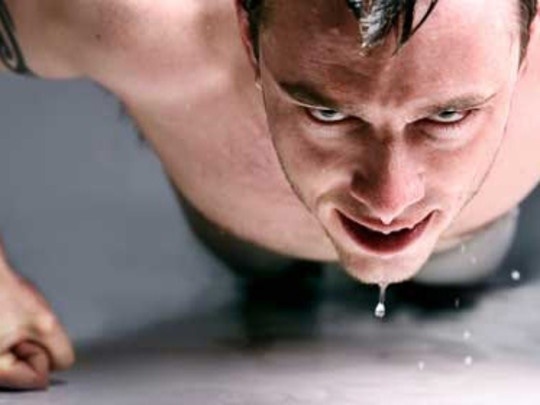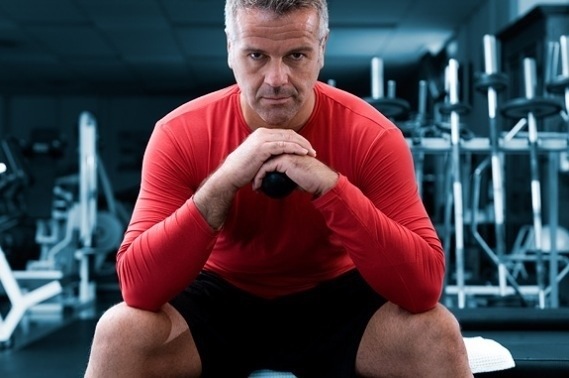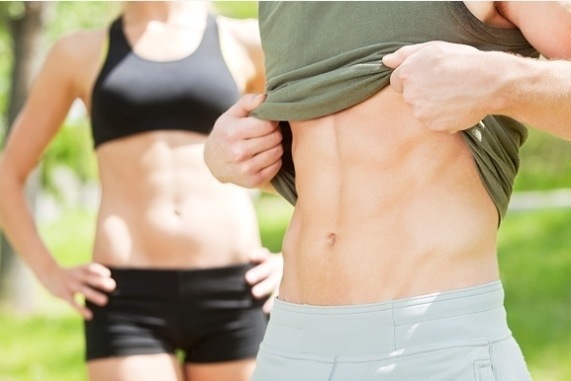
It is still a common misconception that sweating is a legitimate weight loss tactic. This is not only a very big myth but also a potentially dangerous one.
Sweating or perspiring is a thermoregulation process where the sweat glands produce fluid, mainly water and some dissolved solids, that appears on the skin. This fluid is then evaporated creating a cooling effect on body.
As a body gets warm, receptors in the skin send information to the hypothalamus in the brain which then activates sweat glands. Sweating is generally induced by an increase in body temperature due to either weather or activity. It can also be induced by nausea, fever and even nervousness.
The idea that you can lose weight simply by sweating has a small grain of truth. A person can lose about 1 liter of sweat per hour during exercise. A liter of water weighs approx. 2.2lbs, therefore it is technically possible to lose weight due to sweating. The caveat is that this is purely water weight and you will gain it all back once you rehydrate after exercise.
A number of sports such as wrestling and boxing have used extreme sweating as a way to “make weight” for competition. This is usually done just before a bout for the weigh-in. Fighters have been known to drop as much as 10lbs in a day. Then they show up to the bout after adding all this weight right back on. This type of severe weight fluctuation can be potentially dangerous and even fatal.
Saunas and steam rooms really gained popularity in gym facilities and spas in the 1980s. This led to a glut of people sitting around in pools of sweat (both their own and other people’s) thinking that they were amazingly shedding weight. Another popular weight loss fad were PVC sweat suits and the cheaper garbage bag or cling wrap versions. These gained a certain degree of prominence in some jogging circles. Thankfully both trends have mostly subsided, although you will still see the odd disillusioned sole plodding along in their rubber “sweatsuits.”
Another trend or fad, depending on how you look at it, has been Bikram yoga. This is a specific style of yoga practiced in a room heated to 105ºF. Although the founder of this yoga style has claimed performing it in this heated environment has many benefits, it is probably safe to say one of the main reasons for it’s rise in popularity is due to the fact that practitioners believe they are losing more weight during the class because they are sweating more.
If sweating really did help with weight loss, couldn’t a person just lie on the beach in the sun, sweating the pounds off without having to lift a finger? Or why couldn’t they exercise at a very low level in a very hot environment and sweat profusely? The answer is that the amount a person sweats has no real correlation with the amount of weight they can permanently lose.
If you are exercising, and sweating as a result of the exercise, and not a hot environment, then chances are you are doing a certain level of work and therefore you are burning some calories. But you do not have to be drenched in sweat to have performed a hard workout.
Excessive sweating can be a potentially dangerous situation especially if left untreated. The loss of a lot of fluid due to sweating can lead to dehydration, dizziness, heatstroke and even certain cardiovascular conditions. Along with the water loss there is also a loss of certain electrolytes which, if excessive can lead to kidney damage. Every year there are a few isolated cases of fatalities due massive water loss from sweating.
On a side note it has been shown that dehydration slows the use of fat as a fuel and inhibits weight loss.

